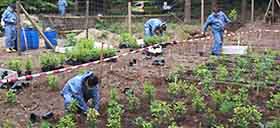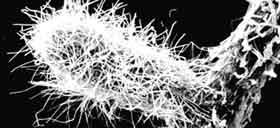Soil Decontamination/ Phytoremediation
After man-made chemical or nuclear accidents, soil often remains contaminated with chemical substances that are dangerous to human health.
In order to recover contaminated soils, chemicals can be extracted either chemically by acids or biologically by plants. The removal by plants is called, phytoremediation. In chemical cleansing the soil has to be removed and treated on a separate site, this procedure is very cos. Phytoremediation takes place on site is much cheaper. Phytoremediation summarizes the processes of phytoextraction, phytodegradation, phytovolatilization, rhizodegradation and rhizofiltration.


Phytoextraction (phytoaccumulation) describes the process of plants absorbing chemical substances from the ground and storing them within the plant. In natural hyper-accumulation this happens unassisted, in induced hyper-accumulation a mobilizing agent is added to the soil. Examples of this process are the extraction of lead by Indian Mustard, Ragweed or Hemp Dogbane, and of Uranium by sunflowers, as applied after the Chernobyl accident.
Phytodegradation (phytotransformation) is the process of, plants absorbing chemical substances from the soil and transforming them into non-toxic substances through their metabolism. Phytovotalization is the removal of substances from soil or water by plants followed by release into the air, possibly after degradation. Rhizodegradation identifies the degradation of substances especially by microorganisms living in a symbiotic-relation at the roots of plants, e.g.fungus. For example this procedure is used to clean up TNT-contamination in the ground of former explosives factories. Rhizofiltration defines the filtration of water through a mass of roots to remove the toxic substances.




